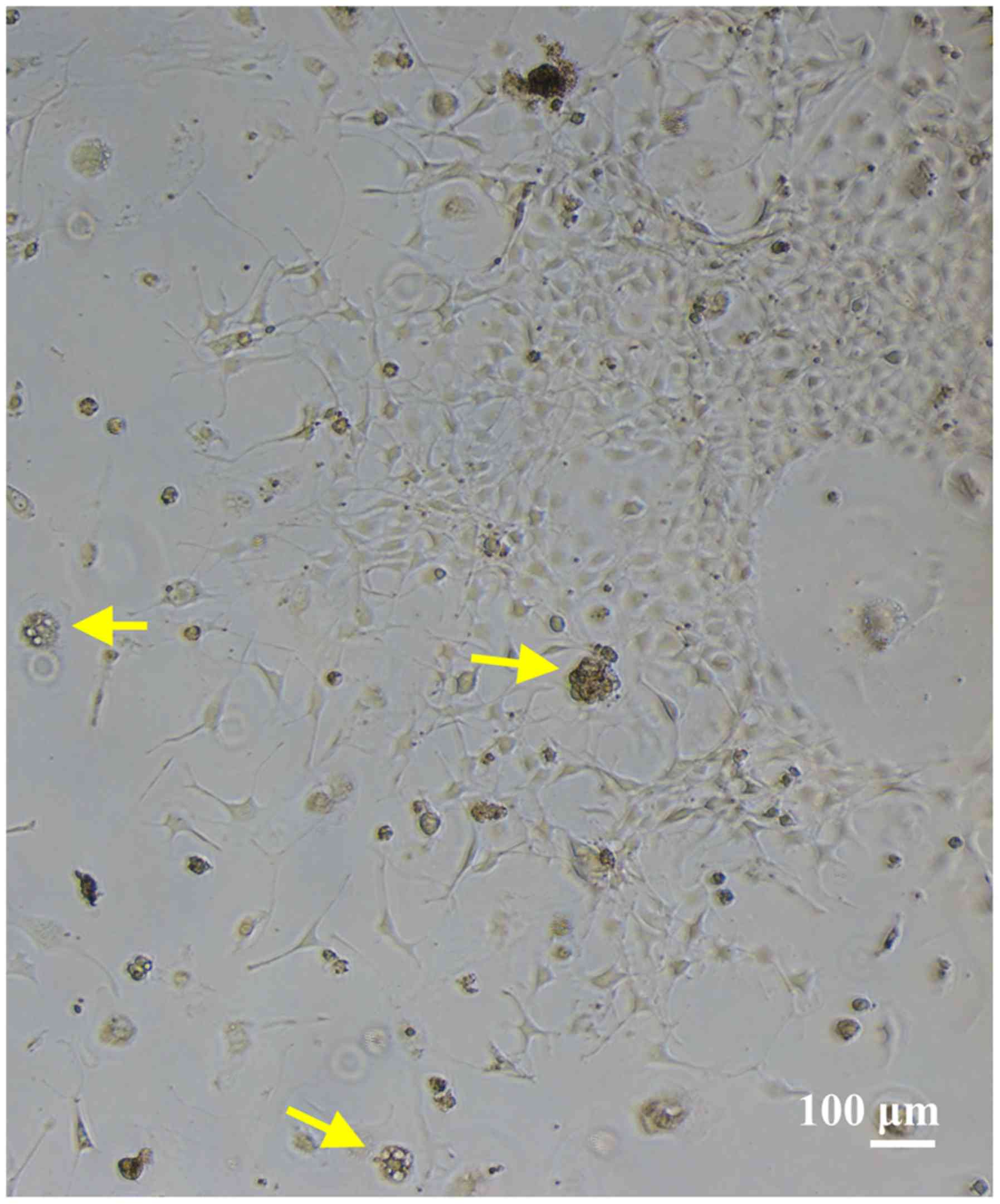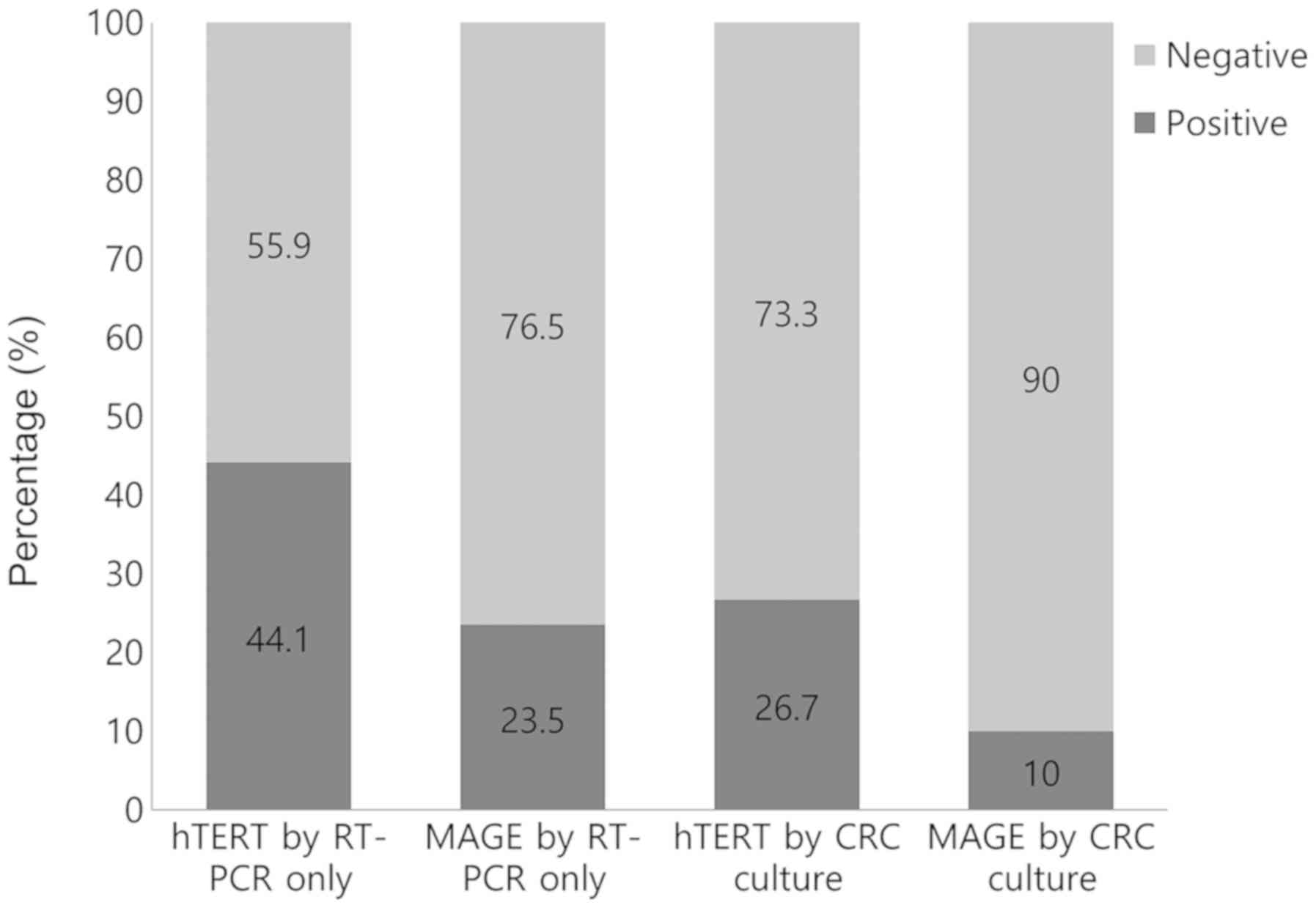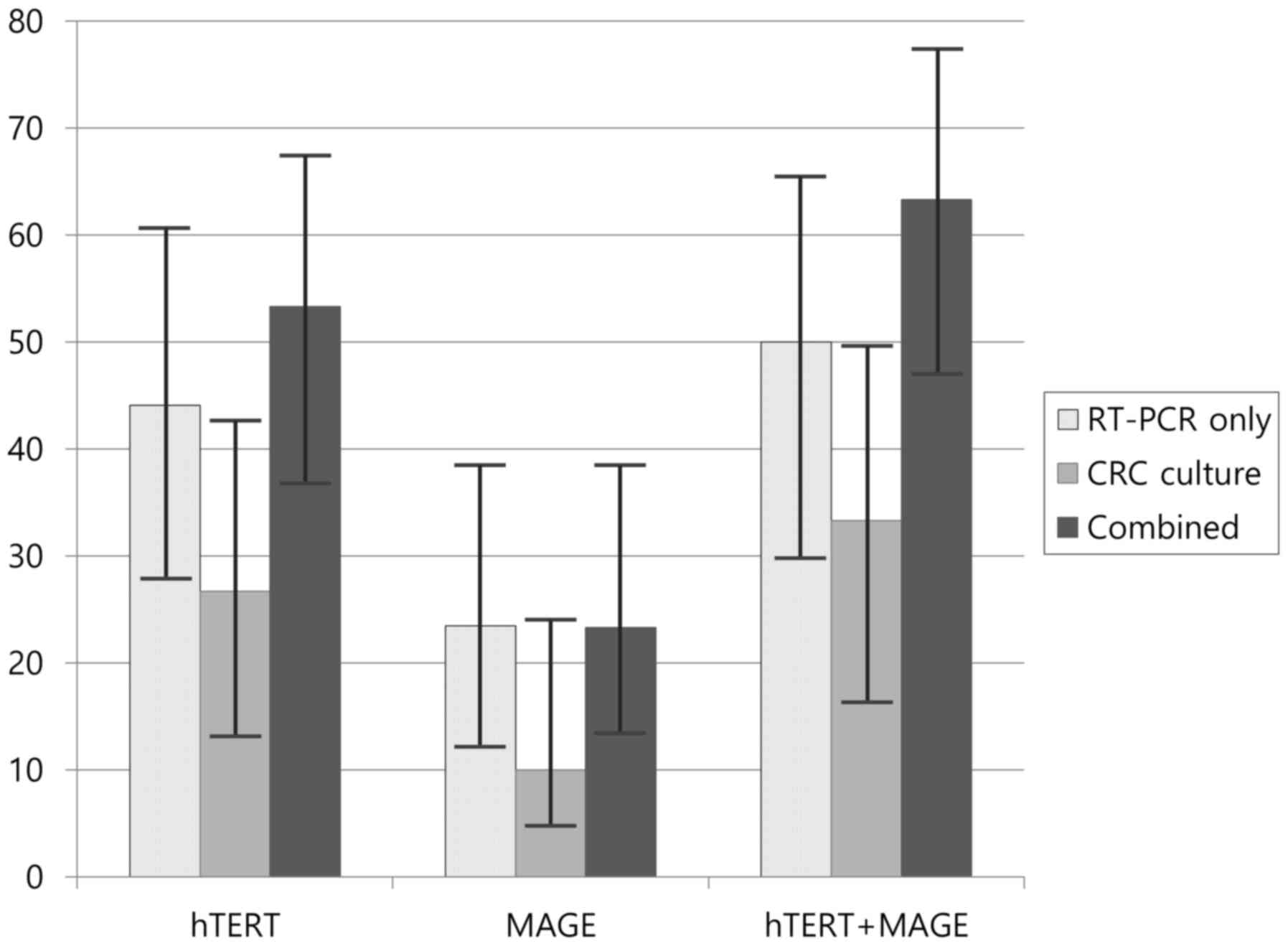|
1
|
Siravegna G, Marsoni S, Siena S and
Bardelli A: Integrating liquid biopsies into the management of
cancer. Nat Rev Clin Oncol. 14:531–548. 2017. View Article : Google Scholar : PubMed/NCBI
|
|
2
|
Gabriel MT, Calleja LR, Chalopin A, Ory B
and Heymann D: Circulating Tumor Cells: A Review of Non-EpCAM-Based
Approaches for Cell Enrichment and Isolation. Clin Chem.
62:571–581. 2016. View Article : Google Scholar : PubMed/NCBI
|
|
3
|
van de Stolpe A, Pantel K, Sleijfer S,
Terstappen LW and den Toonder JM: Circulating tumor cell isolation
and diagnostics: Toward routine clinical use. Cancer Res.
71:5955–5960. 2011. View Article : Google Scholar : PubMed/NCBI
|
|
4
|
Paterlini-Brechot P and Benali NL:
Circulating tumor cells (CTC) detection: Clinical impact and future
directions. Cancer Lett. 253:180–204. 2007. View Article : Google Scholar : PubMed/NCBI
|
|
5
|
Ameri K, Luong R, Zhang H, Powell AA,
Montgomery KD, Espinosa I, Bouley DM, Harris AL and Jeffrey SS:
Circulating tumour cells demonstrate an altered response to hypoxia
and an aggressive phenotype. Br J Cancer. 102:561–569. 2010.
View Article : Google Scholar : PubMed/NCBI
|
|
6
|
Krebs MG, Metcalf RL, Carter L, Brady G,
Blackhall FH and Dive C: Molecular analysis of circulating tumour
cells-biology and biomarkers. Nat Rev Clin Oncol. 11:129–144. 2014.
View Article : Google Scholar : PubMed/NCBI
|
|
7
|
Yu M, Bardia A, Aceto N, Bersani F, Madden
MW, Donaldson MC, Desai R, Zhu H, Comaills V, Zheng Z, et al:
Cancer therapy. Ex vivo culture of circulating breast tumor cells
for individualized testing of drug susceptibility. Science.
345:216–220. 2014. View Article : Google Scholar : PubMed/NCBI
|
|
8
|
Khoo BL, Grenci G, Jing T, Lim YB, Lee SC,
Thiery JP, Han J and Lim CT: Liquid biopsy and therapeutic
response: Circulating tumor cell cultures for evaluation of
anticancer treatment. Sci Adv. 2:e16002742016. View Article : Google Scholar : PubMed/NCBI
|
|
9
|
Maheswaran S and Haber DA: Ex vivo culture
of CTCs: An emerging resource to guide cancer therapy. Cancer Res.
75:2411–2415. 2015. View Article : Google Scholar : PubMed/NCBI
|
|
10
|
Sang M, Wang L, Ding C, Zhou X, Wang B,
Wang L, Lian Y and Shan B: Melanoma-associated antigen genes - an
update. Cancer Lett. 302:85–90. 2011. View Article : Google Scholar : PubMed/NCBI
|
|
11
|
Li X, Hughes SC and Wevrick R: Evaluation
of melanoma antigen (MAGE) gene expression in human cancers using
The Cancer Genome Atlas. Cancer Genet. 208:25–34. 2015. View Article : Google Scholar : PubMed/NCBI
|
|
12
|
Ducrest AL, Szutorisz H, Lingner J and
Nabholz M: Regulation of the human telomerase reverse transcriptase
gene. Oncogene. 21:541–552. 2002. View Article : Google Scholar : PubMed/NCBI
|
|
13
|
Kim DD, Yang CS, Chae HD, Kwak SG and Jeon
CH: Melanoma antigen-encoding gene family member A1-6 and hTERT in
the detection of circulating tumor cells following CD45−
depletion and RNA extraction. Oncol Lett. 14:837–843. 2017.
View Article : Google Scholar : PubMed/NCBI
|
|
14
|
Sachs N and Clevers H: Organoid cultures
for the analysis of cancer phenotypes. Curr Opin Genet Dev.
24:68–73. 2014. View Article : Google Scholar : PubMed/NCBI
|
|
15
|
Zhang Z, Shiratsuchi H, Lin J, Chen G,
Reddy RM, Azizi E, Fouladdel S, Chang AC, Lin L, Jiang H, et al:
Expansion of CTCs from early stage lung cancer patients using a
microfluidic co-culture model. Oncotarget. 5:12383–12397. 2014.
View Article : Google Scholar : PubMed/NCBI
|
|
16
|
Gao D, Vela I, Sboner A, Iaquinta PJ,
Karthaus WR, Gopalan A, Dowling C, Wanjala JN, Undvall EA, Arora
VK, et al: Organoid cultures derived from patients with advanced
prostate cancer. Cell. 159:176–187. 2014. View Article : Google Scholar : PubMed/NCBI
|
|
17
|
Cayrefourcq L, Mazard T, Joosse S,
Solassol J, Ramos J, Assenat E, Schumacher U, Costes V, Maudelonde
T, Pantel K, et al: Establishment and characterization of a cell
line from human circulating colon cancer cells. Cancer Res.
75:892–901. 2015. View Article : Google Scholar : PubMed/NCBI
|
|
18
|
Liu X, Ory V, Chapman S, Yuan H, Albanese
C, Kallakury B, Timofeeva OA, Nealon C, Dakic A, Simic V, et al:
ROCK inhibitor and feeder cells induce the conditional
reprogramming of epithelial cells. Am J Pathol. 180:599–607. 2012.
View Article : Google Scholar : PubMed/NCBI
|
|
19
|
Zheng A, Parasido E, Rawal S, Williams A,
Schlegel R, Liu S, Albanese C, Cote RJ, Agarwal A and Datar RH:
Thermoresponsive release of viable microfiltrated Circulating Tumor
Cells (CTCs) for precision medicine applications. Lab Chip.
15:4277–4282. 2015. View Article : Google Scholar : PubMed/NCBI
|
|
20
|
Wu Y, Deighan CJ, Miller BL,
Balasubramanian P, Lustberg MB, Zborowski M and Chalmers JJ:
Isolation and analysis of rare cells in the blood of cancer
patients using a negative depletion methodology. Methods.
64:169–182. 2013. View Article : Google Scholar : PubMed/NCBI
|
|
21
|
Livak KJ and Schmittgen TD: Analysis of
relative gene expression data using real-time quantitative PCR and
the 2(−Δ Δ C(T)) Method. Methods. 25:402–408. 2001. View Article : Google Scholar : PubMed/NCBI
|
|
22
|
Liu X, Krawczyk E, Suprynowicz FA,
Palechor-Ceron N, Yuan H, Dakic A, Simic V, Zheng YL, Sripadhan P,
Chen C, et al: Conditional reprogramming and long-term expansion of
normal and tumor cells from human biospecimens. Nat Protoc.
12:439–451. 2017. View Article : Google Scholar : PubMed/NCBI
|
|
23
|
Strati A, Markou A, Parisi C, Politaki E,
Mavroudis D, Georgoulias V and Lianidou E: Gene expression profile
of circulating tumor cells in breast cancer by RT-qPCR. BMC Cancer.
11:4222011. View Article : Google Scholar : PubMed/NCBI
|
|
24
|
Wang HY, Ahn S, Kim S, Park S, Jung D,
Park S, Han H, Sohn J, Kim S and Lee H: Detection of circulating
tumor cell-specific markers in breast cancer patients using the
quantitative RT-PCR assay. Int J Clin Oncol. 20:878–890. 2015.
View Article : Google Scholar : PubMed/NCBI
|
|
25
|
Shen C, Hu L, Xia L and Li Y: The
detection of circulating tumor cells of breast cancer patients by
using multimarker (Survivin, hTERT and hMAM) quantitative real-time
PCR. Clin Biochem. 42:194–200. 2009. View Article : Google Scholar : PubMed/NCBI
|
|
26
|
Kwon S, Kang SH, Ro J, Jeon CH, Park JW
and Lee ES: The melanoma antigen gene as a surveillance marker for
the detection of circulating tumor cells in patients with breast
carcinoma. Cancer. 104:251–256. 2005. View Article : Google Scholar : PubMed/NCBI
|
|
27
|
Ferreira MM, Ramani VC and Jeffrey SS:
Circulating tumor cell technologies. Mol Oncol. 10:374–394. 2016.
View Article : Google Scholar : PubMed/NCBI
|
|
28
|
Rack B, Schindlbeck C, Jückstock J,
Andergassen U, Hepp P, Zwingers T, Friedl TW, Lorenz R, Tesch H,
Fasching PA, et al SUCCESS Study Group, : Circulating tumor cells
predict survival in early average-to-high risk breast cancer
patients. J Natl Cancer Inst. 106:1062014. View Article : Google Scholar
|
|
29
|
Fujie T, Mori M, Ueo H, Sugimachi K and
Akiyoshi T: Expression of MAGE and BAGE genes in Japanese breast
cancers. Ann Oncol. 8:369–372. 1997. View Article : Google Scholar : PubMed/NCBI
|
|
30
|
Jungbluth AA, Busam KJ, Kolb D, Iversen K,
Coplan K, Chen YT, Spagnoli GC and Old LJ: Expression of
MAGE-antigens in normal tissues and cancer. Int J Cancer.
85:460–465. 2000. View Article : Google Scholar : PubMed/NCBI
|
|
31
|
Weon JL and Potts PR: The MAGE protein
family and cancer. Curr Opin Cell Biol. 37:1–8. 2015. View Article : Google Scholar : PubMed/NCBI
|
|
32
|
Kirkpatrick KL, Ogunkolade W, Elkak AE,
Bustin S, Jenkins P, Ghilchick M, Newbold RF and Mokbel K: hTERT
expression in human breast cancer and non-cancerous breast tissue:
Correlation with tumour stage and c-Myc expression. Breast Cancer
Res Treat. 77:277–284. 2003. View Article : Google Scholar : PubMed/NCBI
|
|
33
|
Zhang Y, Toh L, Lau P and Wang X: Human
telomerase reverse transcriptase (hTERT) is a novel target of the
Wnt/β-catenin pathway in human cancer. J Biol Chem.
287:32494–32511. 2012. View Article : Google Scholar : PubMed/NCBI
|
|
34
|
Hannen R and Bartsch JW: Essential roles
of telomerase reverse transcriptase hTERT in cancer stemness and
metastasis. FEBS Lett. 592:2023–2031. 2018. View Article : Google Scholar : PubMed/NCBI
|
|
35
|
Hong B and Zu Y: Detecting circulating
tumor cells: Current challenges and new trends. Theranostics.
3:377–394. 2013. View Article : Google Scholar : PubMed/NCBI
|
|
36
|
Wicha MS and Hayes DF: Circulating tumor
cells: Not all detected cells are bad and not all bad cells are
detected. J Clin Oncol. 29:1508–1511. 2011. View Article : Google Scholar : PubMed/NCBI
|
|
37
|
Allard WJ, Matera J, Miller MC, Repollet
M, Connelly MC, Rao C, Tibbe AG, Uhr JW and Terstappen LW: Tumor
cells circulate in the peripheral blood of all major carcinomas but
not in healthy subjects or patients with nonmalignant diseases.
Clin Cancer Res. 10:6897–6904. 2004. View Article : Google Scholar : PubMed/NCBI
|

















